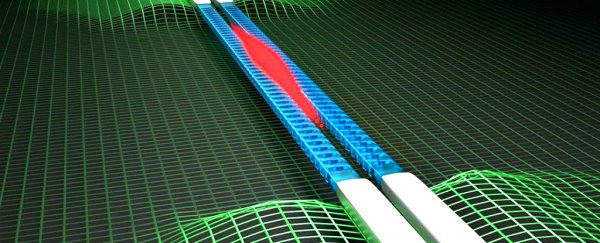Two of the most bizarre phenomena in quantum physics have been brought together in a single experiment for the first time – and scientists are already using the set-up to probe the very limits of reality.
With the aid of two wires placed in very close proximity on a microchip, both the very weird Casimir effect and superconductivity can now be studied at the same time in the same place, something that hasn't been possible before.
This means physicists will finally be able to test some of the current hypotheses that exist around quantum gravity – the idea that quantum forces can explain gravitational pull.
The special device, developed by the researchers from the Delft University of Technology in the Netherlands, uses a novel sensor design to overcome the challenges of getting two wires so close together at ultra-cold temperatures – the temperatures required for the metals to turn into superconductors.
"The strings have holes in the centre that act as an optical resonator," says lead researcher Simon Gröblacher. "Laser light of a certain wavelength gets trapped in there."
"We can use this light to measure small displacements between the two wires, which means that we can measure the forces that are acting upon them at any temperature."
The Casimir effect posits that two objects placed very close together are pushed towards each other by "vacuum particles" – the particles that quantum mechanics says should exist, even in a vacuum.
It's because of the Casimir effect that components can't be packed too closely together on a microchip, and while it's been demonstrated many times, up until now it hasn't been seen in tandem with superconductivity.
Another pillar of quantum mechanics, superconductivity describes the way that certain materials (including aluminum and lead) conduct electricity without any resistance at ultra-low temperatures.
The new mash-up of these two effects on one microchip – maybe a little like a miniature superhero crossover movie – is exciting for scientists wanting to dig deeper into understanding how some of the weirdest ideas in quantum physics work.
All kinds of experiments and measurements could come out of the setup, and the research team is already using its pair of superconducting wires – aluminium in this case – to test various hypotheses from the quantum realm, such as quantum gravity.
"Already, we could disprove one of the more unlikely and controversial quantum gravity theories, which predicted that we should see a strong Casimir-like effect due to gravitational fields bouncing off the superconductors," says one of the researchers, Richard Norte.
"We measured no such effect with our current sensitivity."
That means if a gravitational Casimir effect exists, it's not as strong as scientists previously thought, and plenty of other similar discoveries could be on the way too.
In the future, the researchers want to fine-tune the sensitivity of their device, and may even construct a high-temperature version too.
Because quantum physics operates at the far edges of our scientific understanding and the limits of classical physics, innovative devices like this one and others are going to be crucial in exploring quantum effects further.
"The techniques developed here offer new possibilities towards fundamental physics questions that have been out of reach for conventional experiments," conclude the researchers.
The research has been published in Physical Review Letters.
